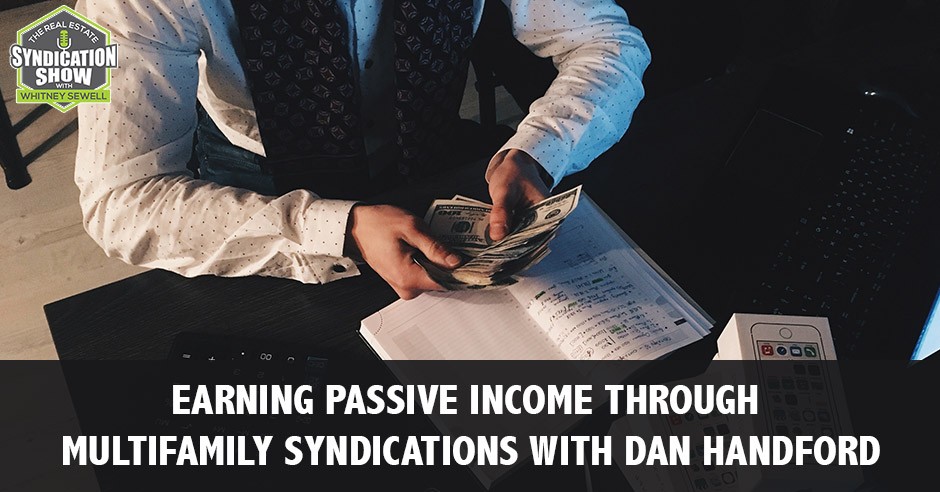Listen to the podcast here:
Multifamily syndication is something to dive right into if you want to take advantage of high-value real estate with high returns. Managing partner of PassiveInvesting.com and Apartments Syndication Company, Dan Handford, joins us to discuss the three criteria for you to consider when you’re looking at investing passively with another syndication. Known as the Founder of Multifamily Investor Nation, he gives away some tips for investing passively in multifamily syndications and shares the details about the upcoming Multifamily Investor Nation Summit.
Our Gracious Sponsor:
Are you wanting to learn how to gain financial freedom through having your own syndication business? Text LEARN to 474747 to begin to learn from one of the best in the industry, Vinney Chopra. Vinney came to the US with only $7 in his pocket, and now controls hundreds of millions of dollars of real estate he has acquired through multifamily syndication. He is now personally coaching others to do the same. Text LEARN to 474747 to begin your journey to starting your own syndication business! Vinneychopra.com
—
Watch the episode here:
Earning Passive Income Through Multifamily Syndications with Dan Handford
Our guest is Dan Handford. Thanks for being here, Dan.
Thanks for having me back. I appreciate it.
Dan’s been here a few times down. We invite you to go back and read WS 14 and also WS 225 to know more about his background and many interesting things, what he’s accomplished and how he’s got going in this business and seeing lots of success. He’s doing very well. A little about Dan before we get going is he’s a managing partner of PassiveInvesting.com, an apartment syndication company that has $130 million and 130 doors. Dan is also the Founder of Multifamily Investor Nation, a nationwide group of over 9,000 elite multifamily investors. Dan, thanks again. Briefly, tell us a little bit about yourself and then let’s jump right into some tips for investing passively in multifamily syndications.
Basically, my background has been in business primarily. My background is in business. The main businesses I have are five non-surgical orthopedic medical clinics. Because of the money that I was making off of that, I needed a place to be able to reduce my taxable liability and with the multifamily real estate, the syndication space, that’s how I was able to achieve that. I love marketing, so I’m a very big marketer. One of the things that we started to do is create our own groups and stuff like that. Before we get started, Whitney, I’d like to share a little bit about the event that we have coming up. I know you’re going to be speaking at the event. It’s called the Multifamily Investor Nation Summit. One of the things that we’ve decided to do for your readers is anybody who uses your promo code Whitney to register for the summit, if you want more information about the summit, it’s all about multifamily. There’s information there about multifamily syndication.
Also if you’re just trying to put together your own deals and find more information about that, you can go to MFINSummit.com and find the 60-plus speakers that’ll be there. It’s all online. You don’t have to leave the comfort of your own home or office. All the sessions will be recorded. It’s June 27th, 28th and 29th. Everybody who goes there from your readers that uses that promo code, all of the revenue that we bring off of the ticket sales from anybody who purchases it, we’re going to donate to the Life Bridge Capital. It’s a non-profit that helps support children adoptions.
Thanks again for that Dan and I hope all the readers will check out the Multifamily Investor Nation Summit. It was a great event last time and it’s amazing that you can watch it from anywhere and anytime, even if you can’t make every session right there, then you can watch it later. You can network with different people online and talk about the events. You sometimes may ask questions while they’re happening. Is that right, Dan?
That’s right. You spoke with the last one, but you were attending another event while I was in person at the same time, weren’t you?
I was. I was speaking at another event and then I took a break and I went to the hotel room. We spoke about that at your event as well. It was great.
[bctt tweet=”The lower the risk, the lower the return.” username=””]
That’s why we’re able to get so many high-quality speakers. It’s because we’re not having to compete with other events because it’s very easy for anybody from anywhere to do. We had speakers from the Bahamas, Israel, Australia, New Zealand, Canada, all coming together in this one live three-day event. I appreciate you speaking in the last time and I appreciate you coming and speaking again at this next one coming up as well.
I’m looking forward to it. Let’s dive in. I know you have some tips for investing passively in multifamily syndication. Let’s get started.
I would probably step on a few toes here, Whitney. Everybody’s concerned about some sort of downturn in the economy or some sort of correction that might be coming up. I’ve come up with these three criteria that when you’re looking at investing passively with another syndication, these are some things that you should look at. These three tips are primarily with multifamily syndication, so it’s a different type of syndication. I would probably say that all three of these would still apply, whether it’d be in multifamily or sell storage or whatever, commercial. All of these would apply. The first one we’re going to talk about is leverage. For those of you who might not know what that term means, it’s how much are you getting this far as a loan is concerned to acquire a particular asset. It’s what they call the loan to value ratio, LTV or that loan to value. That allows you to determine how much you are willing to take on as debt to be able to acquire this asset.
In most situations, we try to take on as much debt as we can because the less amount we have to bring to the table, the higher the returns could be. At the same time, you have to balance that with getting over-leveraged or getting too much debt where you can’t pay your debt service if there is a downturn in the economy. One of the things that you have to look at is when you’re looking at a deal that you’re going to invest passively, where is that leverage component? Where does it land? In most situations, I would say you want to stay around 75% or lower. In certain situations, when you look at them, depending on the asset, it would be okay to go a little bit higher. If you have an asset that’s a much larger asset where you know it’s a more stabilized asset and you can look back at the historicals and see that it’s not really dipped that much, you could maybe stretch it a little bit and go to that 80% leverage. I’ve seen some deals where they had gone to 85%, 86% leverage and I’m just not comfortable with that leverage on these types of assets.
There could be other business plans too that that may change this. Maybe it’s only 50% occupied right now, so the value is really low, but in six months to a year, you’re going to be remodeling, you’re going to be doing things. The value’s going to be drastically higher in a year’s time.
I’m not saying that you should never go over 75%, but if you’re looking to invest passively and you want to stay as conservative as possible, I would say stay below 75% because to me, my comfort level in investing is with preservation of capital. We don’t acquire anything that’s at 50% occupancy because there is no cashflow. As a matter of fact, at 50% occupancy in almost every asset, you’re going to be putting money into that business, into that syndication, for the first year to two years until you get it stabilized. One of the things that we do is we always buy assets that are cashflowing the day we close on them. That way, we do not have to worry about that 50% occupancy. Somebody who goes in and has that stomach for a 50% occupancy, are they going to get a better return if they implement that business plan than me? I would say yes, but you’re balancing risk versus reward. There’s a lot of higher risks and taking on a 50% occupancy in the property versus taking on a 90% occupancy property as well.
75% would be the max usually.
Most of the time right now, we’re trying to get it around about 70%, so give or take one or two points. We go 68%, 69%, 70%, 71%, somewhere around in there as far as the leverage is concerned, but we can go up to 75% on some of these assets. Some asset classes, depending on some of your lenders, they might not allow you to go past that. Most of your lenders they’re going to allow you to go past that. They are what you call your bridge lenders, which are the ones that are in a bridge between a permanent agency debt or fixed debt and they are bridging the gap between you acquiring the property and you’d be able to get it to a point where you can go into some of that permanent debt. Sometimes that bridge is required because you can’t get into an asset when you’re with some of this. Like when our situation with Fannie Mae or Freddie Mac, when you don’t have at least 90% occupancy for at least 90 days. You have to start off with a bridge loan first and get the assets stabilized and then go into that. Even though the bridge lender will give you 80% occupancy at 80% leverage, you don’t always have to take it.

Maybe give us one or two questions we should be able to ask a sponsor or syndicator when we’re just concerning the leverage or the debt.
I would ask them what their plan is. Hopefully, in their presentation, they’ve given you that plan. Unless there’s a reason or a story behind why they’re getting that much leverage, they need to be able to answer that question of, “Why are you getting an 86% leverage? Are you concerned? What are your contingencies in place? Let’s say it is a 50% occupancy. What happens if the day you close the market turns and you’re in this thing with 86% leverage on a 50% occupancy property, are you going to continue to try to build up and get that stabilized? What’s going to happen? Are you going to be able to do that?” A lot of these things are what ifs and they are speculations. I don’t like to invest in speculation and that’s one of the reasons why I like investing in stabilized assets already. I’m not hoping that I can get an increase in occupancy. I’m already at that occupancy level. You have to ask those questions of, “What are the contingencies that you have in place if the day we close or six months down the road after we close, the market turns and we’re still at 50% occupancy?” The worst thing you can do in syndication is you can lose a bunch of people’s money, but when you start to do capital calls, that definitely impacts your investors quite a bit.
75% or lower and we want to be able to ask them what their business plan is and they should be able to answer that. Why are you going to leverage this much? What’s your plan if the market turns? What’s next?
The second thing that I would want you to look at is the operating reserves. Sometimes you look at that and they go, “We have one month of operating reserves and I don’t feel like that’s sufficient.” You need to have more than just one month of operating reserves. As much as you can, have twelve months of operating reserves. A lot of reasons why some of the syndication groups don’t want to have a lot in operating reserves or maybe they don’t put a lot in operating reserves is that the more money that they put in operating reserves is the more money that they have to raise. The more money that they have to raise, it also reduces the returns to the investors. They’re balancing this whole act up, making sure that they can increase the internal rate of return to their investors as well as trying to reduce the amount of money that they have to raise because the more they have to raise, the higher the likelihood that they might not be able to raise that amount. You want to make sure that they have enough in operating reserves to be able to withhold and withstand a storm if it does come. If you look back in 2008 when the market crashed, the properties that we’re able to hold on throughout that dip did very well when they exited their properties. Those are the people that have low leverage and had plenty in operating reserves.
What are you comfortable with? If I’m a passive investor, what’s that answer that you’re looking for there? I can say, “How much are you all putting in reserves so I know that we can weather that storm?”
I think that there has to be an answer that gives you a comfortability level of being able to invest in it. I like to see at least three months, sometimes six months. If it’s an asset and it’s like a tertiary city, you might want a little bit more. It just depends on the asset and it depends on the occupancy that it’s currently at. If you’re acquiring a property that has a little bit lower occupancy, 80%, 85%, you might want to have more in reserves in case it drops below that even more. If you have a more stabilized and a growing economy type market, that’s 95% historically for the last several years. You might not need as much in that operating reserve account. I would say that the more you can have in that operating reserve, the better because it makes for a lower risk deal. The lower the risk, the lower the return. That’s how it works. I would rather have a little bit lower return and have a little bit lower risks so I can practice that SWAN principle, Sleeping Well At Night. That’s really the biggest thing. In a syndication model, we’re taking on outside investor’s money and we want to make sure that we can sleep well at night, but also, our investors can do the same thing.
When you say three to six months of reserves, I wanted to make sure that’s enough to cover all the expenses for three to six months or just the debt?
Correct.
[bctt tweet=”At the end of the day, it’s just business.” username=””]
Is it covering everything? I don’t see how you could get into syndication with no reserves.
I know people have one month and you can hold on for one month. Even if you have one month of reserves, you would’ve been able to last several months over with just one month of reserves because one month of reserves is one month of all of your expenses. If you have a downturn, you have a little drop in your occupancy, the chance of going into 0% occupancy is pretty low. You usually have money coming in, but it still allows you to hold on as long as you need to. Even if you start to get into the property and you realize, “I’ve got three months of reserves, I don’t really need that much because even if we get down to this occupancy level right here, we can last for another eighteen months.” You can start to return some of that capital back to investors throughout the time as well as you start to realize that you’re not going to need that amount of money.
It’s better to have it and not need it than to need it and not have it.
The third thing, the last thing here is this is something that I think is something that I’ve learned from watching other groups. You need to look at the operator and their background and their experience level. Not necessarily just in multifamily. A lot of people are new in this space and I don’t have any problem with that. I’ve been into a little over a year doing it full-time. I feel like though that you need to look for an operator that has some form of experience in business, some background in business to be able to make sure that they can make decisions. At the end of the day, this is a business. When you have downturns in the economy or the property shifts or something that happens on the property, they know how to handle it. I’ll give you an example. I saw on Facebook, somebody posted something about having a slip and fall on their property and they’re getting ready to get sued. They’re worried and they’re freaking out and all this kind of stuff. If you’ve never been sued before, it can definitely be a very scary time. If you’ve been sued before, I’m not saying being sued for something you did wrong or anything like that, but things like that happen in business.
People have slip and falls, you have employee issues, you have certain things that go on and you’re going to get lawsuits. If you’ve been through one of those before, I feel like you know how to handle those a little bit better. What sometimes happens in businesses, is we get a lawsuit and our focus shifts to the lawsuit and all of a sudden, the business starts to go down. You have to be able to make sure you know how to balance both of those. That’s just one example. Some people I have told that to, they’ve said, “I’ve never had any background in business before, so what do I do?” I think that’s one of the reasons why in this space you have to partner with other people. You have to partner with people that have some form of background and experience in either multifamily or in business in general. That helps to round out and shape your group to allow people, the investors, to feel comfortable investing with you.
Even if you haven’t been sued before, but if you have a background in business, there are things like that that come up that you just train your mind to respond differently. “We’ll get through it. It’s not a big deal.” You’re going to research and you’re going to figure out, you’re going to make it happen. You’re going to figure out ways that it’s not going to overtake your life because you know you’re going to overcome it.
I told that person, “If somebody slipped and fall and they’re going to file a claim, you’re going to be sued and there’s going to be a settlement. That’s why you have insurance. You can’t lose sleep over that. That’s just business. It’s going to happen and you have to have your insurance write the check.” “What about the insurance going up?” That’s part of the business. It’s going to go up, so you have to understand what’s going to happen and realize, “It’s okay. It’s part of the business.”
It’s really those life experiences that this syndicator or somebody’s had beforehand, but specifically this time in business.

Those are the three things that I would recommend. You shouldn’t be overleveraged and not have enough in operating reserves. The last thing is teaming up with an operator that has a good background in business or even have some track record in multifamily.
I can see where a lot of readers are saying, “How do I get started? I’ve got this W-2 income, I’ve had a W-2 job for however many years. I have been an entrepreneur. How do I get started?” It sounds like you’d recommend finding another syndicator that has experience and partner with them.
Going back to what we did prior to this, we talked all about meetups and how to leverage meetups to be able to meet people and network with people. That’s a great way to find your next partner, is being able to go to those meetups and meeting people that you know and networking with people that have a little more experience in a different area. That way you can start to team up with people that you can start to trust as well.
Dan, how can they get in touch with you and then tell them again about this promo code for the Multifamily Investor Nation Summit.
For those of you who are interested in possibly passively investing with our group, we have a group called PassiveInvesting.com. You can go there. There’s a form there on the website you can fill out that you can jump on a phone call with me and I’ll just jump on there on a phone call with you to discuss your investment goals if you’re interested in joining our group. You can also join our Multifamily Investor Nation group. You can go to MultifamilyInvestorNation.com, find out more information about us there. Follow us on Facebook, as well as YouTube and LinkedIn. For those of you who are interested in the Multifamily Investor Nation Summit, it’s going to be an online virtual summit. Whitney is going to be speaking there for the second time and we’re going to have over 60 speakers, over 1,000 attendees. If you use the promo code Whitney to be able to register for your ticket, all of the proceeds that we collect off of that promo code, we’re going to donate to the Life Bridge Capital non-profit that helps support the children adoptions. You can go to MFINSummit.com and find out more information about it and register for the summit coming up.
Thank you again for that, Dan, and I appreciate your support very much. I hope readers will take advantage of that and use the promo code Whitney. I also hope you’ll go to Life Bridge Capital and connect with me. I’d love to get on the phone with you as well, then go to our Facebook page, The Real Estate Syndication Show where we can all learn and grow our businesses together from experts like Dan. Until next time.
Important Links:
- Dan Handford
- WS 14 – Past episode
- PassiveInvesting.com
- Multifamily Investor Nation
- Multifamily Investor Nation Summit
- MFINSummit.com
- MultifamilyInvestorNation.com
- Facebook – Multifamily Investor Nation
- YouTube – Multifamily Investor Nation
- LinkedIn – Multifamily Investor Nation
- The Real Estate Syndication Show – Facebook group
- WS 225 – Past Episode
About Dan Handford

Dan has an extensive successful background in starting multiple seven-figure businesses from scratch including a large group of non-surgical orthopedic medical clinics located in South Carolina. His family of companies have annual budgets in excess of $10MM.
He is the founder of the Multifamily Investor Nation where he educates a nationwide group (9,000+ members) of multifamily investors on how to properly invest in multifamily assets.
He is the co-host, along with his wife, Dennae, of the Tough Decisions for Entrepreneurs podcast which can be found on iTunes and Google Podcasts.
Love the show? Subscribe, rate, review, and share!
Join the Real Estate Syndication Show Community:



